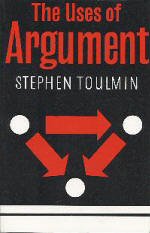 Stephen Toulmin
Stephen Toulmin
Cambridge University Press, 1958
 Stephen Toulmin
Stephen Toulmin
Cambridge University Press, 1958
ISBN 0521092302 (paper)
Buy it from Amazon.com
Buy it from Amazon.co.uk
Buy the E-Book for Electronic Download from Amazon.co.uk
This short and readable philosophy book has been reprinted at least 15 times since its first publication nearly half a century ago. It has influenced people far outside the quiet realms of philosophy and logic -- linguists, lawyers, and computer scientists among them.
The book has indeed founded almost single-handed the field of Visualizing Argumentation, now studied extensively under the umbrella of Computer-Supported Co-operative Work. Numerous patent methods and tools attempt to model arguments broadly in the manner that Toulmin suggests, the most important from the point of view of systems engineering being safety case argumentation methods such as Adelard's ASCAD and the University of York's GSN.
The crux of Toulmin's argument is that Aristotelian logic, with its neat mathematical syllogisms, simply doesn't apply to the real world. When arguments are 'substantial', i.e. a substantial leap is required to get from facts to a conclusion, rather than when the conclusion is logically entailed by the premisses, then formal logic just doesn't help. "All men are mortal; Socrates is a man; ergo Socrates is mortal" is all very well in logic school and the maths class -- but outside, you actually never know enough to state the rule, and you usually don't have perfect data either. (Even the word 'fact' comes from the Latin verb facere meaning 'to make': a fact is something that you have made or established by observation, experiment, or argument, not a given in nature.)
So if we can't have logic, how can we ever know anything? You can feel the discomfort; thousands of unbearably clever theses have argued that everything is relative, uncertain, and even worse, that the feeling that we know anything is just that, a feeling that we delude ourselves with. You know the sort of stuff -- everything is just a social construct, reality is not observable, and claims to knowledge are merely assertions of power -- the sort of thing that got philosophy a bad name.
Toulmin comes to the rescue, showing that indeed logic can't save us, but that instead, there are perfectly serviceable ways of arguing and justifying our conclusions that stop short of attaining certainty. We use them every day, and so do lawyers in court. In fact, every profession has its own forms of argument, and Toulmin ends the book by suggesting that there may be many schemata or patterns of possible argument:
they should .. scrutinise the logical history, structure and modus operandi of the sciences using the eye of a naturalist, without preconceptions or prejudices imported from outside. This will mean seeing and describing the arguments in each field as they are, recognising how they work...
This may be a terrible shock to logicians who entertain claims of universal validity, but it ought to be a relief to the rest of us. Engineering arguments need to be put together in a way that makes clear how confident we can be in our conclusions. Do we know that signalling system is safe, or are we just hoping for the best? Toulmin proposes a simple and really quite general scheme for representing arguments, and it has turned out to be very suitable for machine representation and for diagramming (at least when gently modified to make it easier to handle, as described in my article Modelling Argumentation, Toulmin-style). A Conclusion is reached, more or less definitely, from some data, by way of a Warrant for the jump from the one to the other.

The warrant is necessary precisely because formal logic can't be applied. The fact that the person I'm looking at has fair skin, red hair and freckles absolutely does not entail the conclusion that they'll easily get sunburnt -- it isn't a tautology. What it is, is a practically-certain conclusion, given some knowledge of physiology. Our warrant is something like 'People with red hair, fair skin and freckles are adapted to high northern latitudes where sunlight is scarce. They usually burn rapidly in the sun.' We could be deceived - maybe the person has been beautifully made-up for a film shot -- but otherwise we are pretty sure we are right. All these 'practically-certain's and 'pretty sure's are nonsense to the logician, but meat and drink in everyday life, and in requirements and systems engineering.
Warrants in their turn may need to be supported by Backings, which could just be single statements of arguments, but which could equally be Conclusions to be established in their turn by way of further Warrants, and so on.
Finally, the plausibility of a Conclusion can be challenged by a Rebuttal, which is yet another piece of argumentation. The scheme is simple, robust, and like all good things obvious with hindsight.
This little book has stimulated and encouraged many practical lines of enquiry. It seems to me the best sort of academic work: clear, cogent, sweeping away the cobwebs of a lot of muddled thinking, and opening up a whole new field with immediate benefits to practical people in many walks of life. Engineers may well find it directly useful, at least in its conclusions; students may well find it helps them to think in a practical way; and researchers may discover yet more interesting avenues to pursue through its carefully-reasoned pages (not to mention all the literature that it has spawned).
© Ian Alexander 2003
You may also like: